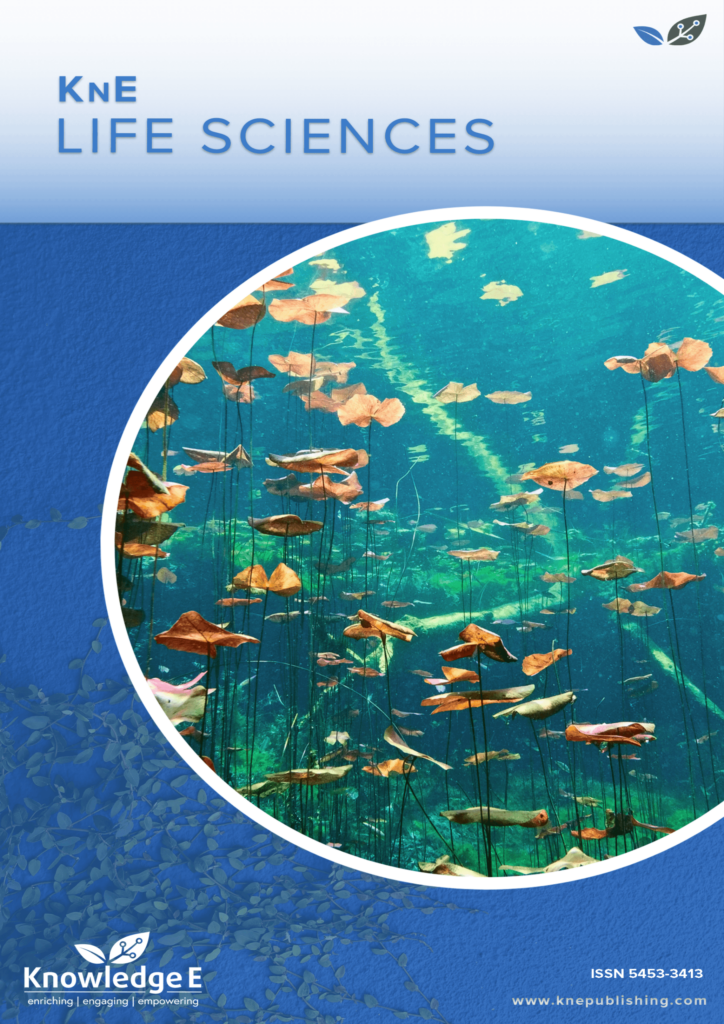
KnE Life Sciences
ISSN: 2413-0877
The latest conference proceedings on life sciences, medicine and pharmacology.
Propolis Potential Toward the Amount of Limphoblast and Spleen Diameter of Male Mice (Mus musculus)
Published date:Dec 03 2017
Journal Title: KnE Life Sciences
Issue title: The Veterinary Medicine International Conference (VMIC)
Pages:386-394
Authors:
Abstract:
The aim of this research was to find out the effect of propolis in the amount of lymphoblast and the correlation between the treatment of propolis with spleen diameter each of white male mice (Mus musculus). This research used 25 male white mices which are 12 weeks old has 25-35 gram of body weight. They were divided randomly into five groups. (P0) as control was given 0,5 ml aquades/day, and other group were given propolis for 0.4 mg/0.03kg/day (P1), 0.8 mg/0.03kg/day (P2), 1.6 mg/0.03kg/day (P3), and 3.2 mg/0.03kg/day (P4). After two weeks treatment, 25 mices were sacrificed their spleen were then used in histological preparation with HE staining. The data were analyzed by ANOVA method based on Completely Randomized Design and further analyzed by Duncan's Multiple Range Test. The result from statistical analysis showed that treatment with propolis increased the amount of lymphoblast also the spleen diameter of white male mice (p<0,05) and show positive correlation amount of lymphoblast and white pulp spleen diameter.
Keyword: propolis, lymphoblast, white pulp, spleen
References:
[1] H. Ichikawa, K. Satoh, T. Tobe, I. Yasuda, F. Ushio, K. Matsumoto, K. Endo, and C. Ookubo, Free Radical Scavenging Activity Of Propolis. n Redox Rep. 7 (5) (2002) 347-350.
[2] F. Missima, A. C. Pagliarone, C. L Orsatti., J. M. Sforcin, The Effect of Propolis on Pro-Inflammatory Cytokines Produced by Melanoma-Bearing Mice Submitted to Chronic Stress. Journal of ApiProduct & ApiMedical Science. 1 (2009) 11–15.
[3] K. A. Abbas, A. H. Lichtmant, S. Pillai, Cellular and Molecular Immunologi, 6th ed. Philadelphia: W.B. Saunders Company, 2007.
[4] F. D. Batista, N. E. Harwood, The Who, How and Where of Antigen Presentation to B cells,. Nature Reviews Immunology, 9 (2009) 15-27.
[5] I.R. Tizard, Veterinary Immunology: An Introduction, 7th ed, China: Saunders, 88-91, 2004.
[6] K. G. Baratawidjaya, I. Rengganis, Imunologi Dasar, 9th ed., Jakarta, Balai Penerbit Fakultas Kedokteran Univeritas Indonesia, 2010.
[7] D. K. Yuliawan, Pengaruh Pemberian Simunox Dosis Bertingkat terhadap Proliferasi limfosit pada Mencit Swis, Skripsi, Fakultas Kedokteran Universitas Diponegoro, Semarang, 2010.
[8] V. Bankova, Recent Trends and Important Developments in Propolis Research, eCAM 2 (2005) 29-32.
[9] M. L. Khalil, Biological Activity of Bee Propolis in Health and Disease. Asian Pac. J. Cancer Prev. 7(1) (2006) 22-31.
[10] A. H. Banskota, Y. Tezuka, S. Kadota, Recent Progress in Pharmacological Research of Propolis. Phytoter Res 15(7) (2001) 561-571
[11] S. Suhirman, C. Winarti, Prospek dan Fungsi Tanaman Obat sebagai Imunomodulator, Buletin Perkembangan Teknologi Tanaman Rempah dan Obat 19(2) (2007) 121-133.
[12] J. M. Sforcin, G. A. Nunes F. Missima, A. Nunes, L. H. Faccioli, Effect of a Leukotriene Inhibitor (MK886) on Nitric Oxide ond Hydrogen Peroxide Production oy Macrophages of Acutely an Chronically Stressed Mice. Journal of Pharmacy and Pharmacology 59 (2007) 1249-1254.
[13] N. Orsolic, I. Basic. Immunomodulation by Water Soluble Derivates of Propolis: Factor of Antitumor Reactivity. Journal of Etnopharmacology 23(8) (2003) 265-273.
[14] E. Middleton, C. Kandaswarni, and TC. Theoharides,. The Effect of Plant Flavonoid on Mammalian Cell: Implication For Inflammation, Heart Disease, and Cancer. Pharmacological Reviews 52(4) (2000) 673-751.
[15] M. Syaifulhaq, Pengaruh Pemberian Ekstrak Buah Mahkota Dewa Dosis Bertingkat terhadap Proliferasi Limfosit Lien pada Mencit BALB/C. Biomedika 2 (1) ( 2009) 33-36.